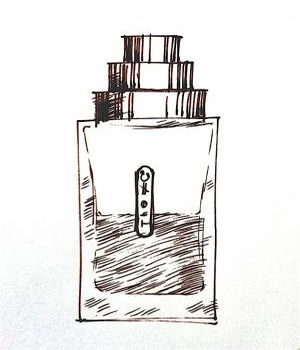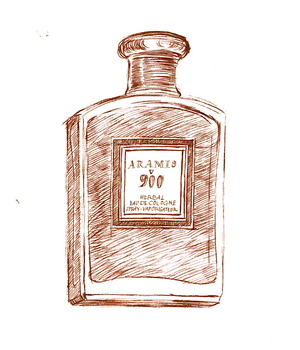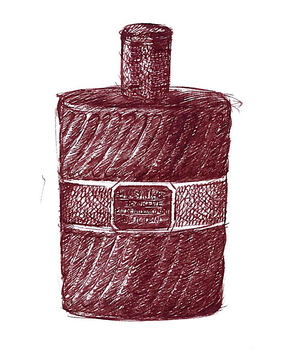Tagged With ‘lemon’
Different Company
Osmanthus
8 July, 2014
 Much excitement in Weymouth, as the old Woolworth’s site has been transformed into a branch of T.K.Maxx. Even more excitement when, on our first visit, what should I pluck from the trashy mass-market scents you’d expect to find in a discount outlet but a brand-new bottle of Osmanthus by The Different Company.
Much excitement in Weymouth, as the old Woolworth’s site has been transformed into a branch of T.K.Maxx. Even more excitement when, on our first visit, what should I pluck from the trashy mass-market scents you’d expect to find in a discount outlet but a brand-new bottle of Osmanthus by The Different Company.
What a highly collectible perfume by a fairly obscure, high-end brand was doing in the Weymouth branch of T.K.Maxx I have no idea, but there it was, ours for the princely sum of £16.99 (recommended retail price €142).
Created by the much-admired perfumer Jean-Claude Ellena (now the in-house perfumer for Hermès) for the company he founded in 2000, Osmanthus gets an admiring review in the even more widely admired Perfumes: The Guide by Luca Turin and Tania Sanchez, and you can see why.
It’s a gentle, sweet but subtle scent, whose plush peachy centre is reminiscent of Guerlain’s timeless Mitsouko, though it seems to lack either Mitsouko’s strength of character or its mysterious staying-power. Yet Osmanthus has magic of its own, and its apparent evanescence on the skin proves something of a disappearing trick – for after putting a little on the back of my hand and noting that it didn’t seem to last very long, what should happen but that an hour or two later, as if from nowhere, its fresh, fruity scent would suddenly snap into focus again, almost as strong as when I first sprayed it on.
I’ve no idea how it’s done, or even whether the effect was intentional, but my guess is that it’s got something to do with the way Osmanthus’ peachiness bonds with the perfume’s other elements, some of which are a little surprising, like castoreum, a resinous compound extracted from beavers that has a leathery, animalic smell and is also found in Chanel’s wonderful Cuir de Russie.
Natural osmanthus, incidentally, is an attractive evergreen shrub which, in sheltered conditions, will grow to the size of a small tree. It grows wild in the Himalayas, China and Japan and was first introduced to European gardens in 1771, where it became known as Sweet Tea or Fragrant Olive. In the autumn it bears thousands of small but intensely fragrant white flowers, whose intoxicatingly sweet scent gives the plant its botanical name, Osmanthus fragrans.
Its fragrance, indeed, is remarkably powerful, as we discovered on an autumn visit to the enchanted garden of Brécy, near Bayeux. From the massively stepped levels of the formal gardens, which form a kind of vast single staircase up towards the Normandy sky, we recognised osmanthus’ heady scent a long time before we finally located its source, from a couple of dark columnar trees planted close against the south wall of the church, outside the gardens themselves.
Despite the sheer intensity of its fragrance, this is one of the only powerfully sweet scents I know that one can never smell enough (unlike, say, Madonna lilies, whose scent becomes overwhelming after a while): there’s a fresh lemony edge to osmanthus that makes it refreshing and intoxicating all at once. Enjoy Jean-Claude Ellena’s perfume by all means, but plant the tree wherever you can.
Aramis
Aramis 900
9 June, 2014

Aramis is one of those mid-market brands that seems to have been around for ever, and for that reason it’s often overlooked or, worse, looked down upon. Which is, I think, a shame, because there are some classic men’s perfumes in the range.
The all-men’s brand was launched in 1964 by Estée Lauder and her husband Joseph, with the eponymous Aramis (which I’ve reviewed here) as the first fragrance in the range. Though I’d always assumed the brand and the perfume were named after the character in The Three Musketeers, legend has it that it actually commemorates an obscure town in Armenia, which these days is transliterated as Yeremes. It sounds like a leg-pull, but then we’re also told that the Lauders were working with an Armenian designer at the time by the name of Arame Yeranyan, so you never know; I’ll let you know if I can get a definitive answer out of somebody.
Whatever the truth of the matter (and the perfume industry’s relationship with historical fact can sometimes be rather shaky), Aramis was a big success, and in 1973 it begat Aramis 900. Like the original Aramis it was created by Bernard Chant, a brilliant French perfumer who loved spicy, leathery fragrances, and it’s very much along those lines.
In fact, as it’s often been pointed out, if Aramis 900 hadn’t been marketed for men, it would have worked just as well as a woman’s scent – a good example of the obvious but too rarely grasped fact that in itself perfume has no gender. Just smell Clinique’s classic woman’s perfume, Aromatics Elixir, and you’ll see what I mean: it was also created by Bernard Chant and to many people smells identical to Aramis 900.
Aramis 900 is a deep, spicy, complicated scent, which makes most contemporary offerings smell weedy and washed-out by comparison. Today you’d only expect to find a men’s fragrance smelling this rich and complex in an expensive ‘exclusive’ range like Tom Ford or Armani Privée, but when it was launched it was aimed squarely at the middle market: these were not expensive perfumes.
Like the majority of other men’s perfumes, Aramis 900 includes lemon and bergamot, but among its more persistent and powerful ingredients are carnation, orris (iris) root, geranium, oakmoss, patchouli and vetiver, as well as rosewood oil, the natural form of which comes from an increasingly threatened rainforest tree, Dalbergia nigra.
Unlike most modern men’s perfumes, though, Aramis 900 has a predominantly floral scent, which to me smells like a mix of clove-scented carnation and old-fashioned rose. Though floral fragrances were popular with Victorian men, in 20th-century western culture they came to be thought of as ‘girly’, though for no particularly logical reason as far as I can see.
Luckily that didn’t stop perfumers from using floral ingredients in men’s perfumes, but in the case of Aramis 900 those flowery scents are brilliantly disguised by all sorts of other things, including a faintly ‘dirty’ smell that adds an oddly sexy extra to the mix. The forest-floor oakmoss and vetiver also stop it smelling sweet, while the carnation (despite being a flower) gives it the same kind of peppery spiciness that you can smell in Chanel’s Egoïste.
The amazing thing, to me, is that perfumes like Aramis 900 have been so cheap for so long, but in 2009 it seems to have dawned on Estée Lauder Inc what they had on their hands, and six perfumes in the Aramis range – including Aramis 900 – were relaunched and repackaged in matching bottles. Now priced at a less mass-market £60 and titled a ‘Gentleman’s Collection’, presumably the hope is that men who liked one fragrance might go on to collect the rest. Given the quality of most men’s fragrances today I’d say that wouldn’t be a bad idea.
Christian Dior
Eau Sauvage
3 March, 2014
 How did I get this far without reviewing Eau Sauvage? And now that I’ve finally got round to reviewing it, how am I going to do justice to such an iconic perfume? OK, I’ve covered Eau Sauvage Extrême, but that’s a dreary spin-off and bears little relation to the glorious real thing. So, deep breath now, and here we go.
How did I get this far without reviewing Eau Sauvage? And now that I’ve finally got round to reviewing it, how am I going to do justice to such an iconic perfume? OK, I’ve covered Eau Sauvage Extrême, but that’s a dreary spin-off and bears little relation to the glorious real thing. So, deep breath now, and here we go.
Created by the legendary perfumer Edmond Roudnitska, Eau Sauvage was launched in 1966, and it’s deservedly regarded as one of the greatest men’s perfumes of all. Roudnitska’s took the idea of a classic men’s cologne, packing it full of fresh, zingy, clean-smelling bergamot-orange oil from southern Italy, but then he did a brilliant thing, by blending it with an equally strong dose of a recently patented chemical called Hedione.
Hedione smells of jasmine – as well it might, since it was discovered by chemists during the process of deconstructing the molecular bits and bobs that, collectively, create natural jasmine’s heady, narcotic scent. Hedione’s real name is methyl dihydrojasmonate, and it was first isolated in 1958 by Dr Edouard Demole, who worked for the giant Swiss perfume company Firmenich.
Methyl dihydrojasmonate has a light jasmine smell but also something citrusy about it, giving Edmond Roudnitska a jigsaw piece that fitted into both the bergamot orange of a man’s cologne, and also had something – but crucially not too much – of natural jasmine’s sumptuous, powerfully floral scent, which most men would have considered far too feminine to wear.
To this Roudnitska added lavender – another floral scent, though this time one whose herby, faintly sweaty character had made it a long-standing male favourite – as well as a range of other, less pronounced ingredients including oakmoss (originally extracted from a lichen that smells of forests after rain) and patchouli, which in small amounts, I’m guessing, enhances the dandified character of Eau Sauvage without pushing it over into full-on let-it-all-hang-out hippiness.
A great perfume is one thing, and an all-too-rare thing at that, but it’s rarer still for a brilliant perfume to be supported by great marketing and presented in a great bottle. And here Eau Sauvage struck lucky again. Christian Dior died in 1957 of a heart attack, but under Yves Saint Laurent and then Marc Bohan, the company commissioned a series of sexy, tongue-in-cheek yet effortlessly elegant posters from René Gruau, arguably the greatest fashion illustrator of the 20th century. They certainly added to Eau Sauvage’s masculine appeal.
Few of us think a great deal about the bottles that contain the perfume we use, though they do have their collectors (most of whom, oddly, seem to have lost interest in the perfumes they contain). But some bottles repay a second glance, and Eau Sauvage is one of them. It was designed by Pierre Camin, who worked for Baccarat and created many of the bottles for the perfumer François Coty, and its chic silver cap, embossed with a pattern of tiny overlapping scales like a freshly-caught mackerel, is said to have been inspired by the silver thimble that Christian Dior always had to hand. The diagonally ridged sides of the bottle itself, meanwhile, are supposed to resemble the regular pleats of a Dior dress, though that seems a bit of a stretch to me.
I could go on, but in the unlikely event that you’ve never smelled Eau Sauvage, or think of it as a tired old dinosaur, I’d rather you headed out and tried it for yourself. Just be careful, though, as Dior have experimented with different versions over the years, and what’s now called Eau Sauvage Extrême (which you’d think would just be a stronger version, as indeed it used to be) is now a completely different fragrance, pleasant enough in a dull way but far less exciting than the original.
My last words, though, go to Edmond Roudnitska, not only because he was a perfumer of genius, but also because he also had something so important to say about marketing that it should be tattooed on the forehead of every perfume-company PR.
‘The choice of a perfume,’ he said, ‘can only rest on the competence acquired by education of olfactive taste, by intelligent curiosity and by a desire to understand the WHY and the HOW of perfume. Instead, the public [is] given inexactitudes and banalities. The proper role of publicity is to assist in the formation of connoisseurs, who are the only worthwhile propagandists for perfume, and it is up to the perfumers to enlighten, orient and direct the publicity agents.’
Here’s to the day his dream comes true.